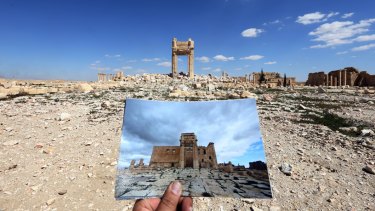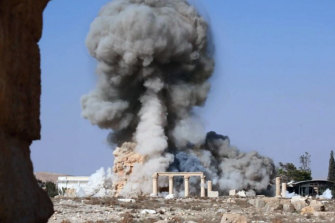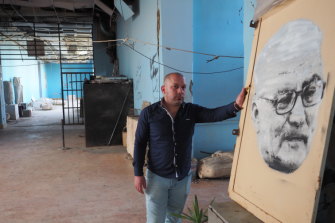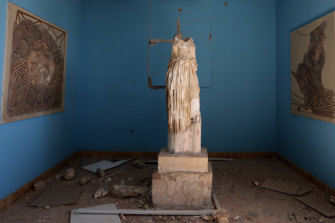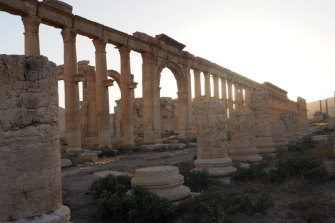As we commemorate the 80th anniversary of the beginning of the Second World War, with Germany’s unprovoked invasion of Poland on 2nd September, and Britain and France’s declaration of war on Germany the day after, let us bow our heads for the victims of Nazism.
The term ‘Holocaust’ generally refers to the systematic and industrialized mass murder of the Jewish people in German-occupied Europe – called the Shoah or ‘catastrophe’ by Jews. But the Nazis also murdered unimaginable numbers of non-Jewish people considered subhuman – Untermenschen (the Nazis had a way with words!) – or undesirable.
Non-Jewish victims of Nazism included Slavs who occupied the Reich’s ostensible lebensraum – living space, or more bluntly, land grab (Russians – some seven million – Poles, another two – Ukrainians, Serbs and others in Eastern Europe caught in the Wehrmacht mincer; Roma (gypsies); homosexuals; the mentally or physically disabled, and mentally ill; Soviet POWs who died in their tens of thousands; Roman Catholics, Protestants, and Orthodox Christians who defied the regime; Jehovah’s Witnesses and Freemasons; Muslims; Spanish Republicans who had fled to France after the civil war; people of colour, especially the Afro-German Mischlinge, called “Rhineland Bastards” by Hitler and the Nazi regime; leftists, including communists, trade unionists, social democrats, socialists, and anarchists; capitalists, even, who antagonized the regime; and indeed every minority or dissident not considered Aryan (‘herrenvolk’ or part of the “master race”); French, Belgians, Luxemburgers, Dutch, Danes, Norwegians, Albanians, Yugoslavs, Albanians, and, after 1943, Italians, men, women and young people alike, involved with the resistance movements or simply caught up in reprisals; and anyone else who opposed or disagreed with the Nazi regime. See below, Ina Friedman’s The Other Victims of the Nazis and also, Wikipedia’s Victims of the Holocaust
The Nazis, with a little help from their allies and collaborators, murdered (there is no other word) an estimated six million Jews and 11 million others In camps and jails, reprisals and roundups, on the streets of cities, towns and villages, in fields and in forests, and in prison cells and torture chambers. And in the fog of war, the dearth of accurate records, and the vagaries of historical memory, the actual number is doubtless higher – much higher.
Lest we forget …
Worldwide, over seventy million souls perished during World War II. We’ll never know just how many …
| Country |
Military Deaths |
Total Civilian and Military Deaths |
| Albania |
30,000 |
30,200 |
| Australia |
39,800 |
40,500 |
| Austria |
261,000 |
384,700 |
| Belgium |
12,100 |
86,100 |
| Brazil |
1,000 |
2,000 |
| Bulgaria |
22,000 |
25,000 |
| Canada |
45,400 |
45,400 |
| China |
3-4,000,000 |
20,000,000 |
| Czechoslovakia |
25,000 |
345,000 |
| Denmark |
2,100 |
3,200 |
| Dutch East Indies |
— |
3-4,000,000 |
| Estonia |
— |
51,000 |
| Ethiopia |
5,000 |
100,000 |
| Finland |
95,000 |
97,000 |
| France |
217,600 |
567,600 |
| French Indochina |
— |
1-1,500,000 |
| Germany |
5,533,000 |
6,600,000-8,800,000 |
| Greece |
20,000-35,000 |
300,000-800,000 |
| Hungary |
300,000 |
580,000 |
| India |
87,000 |
1,500,000-2,500,000 |
| Italy |
301,400 |
457,000 |
| Japan |
2,120,000 |
2,600,000-3,100,000 |
| Korea |
— |
378,000-473,000 |
| Latvia |
— |
227,000 |
| Lithuania |
— |
353,000 |
| Luxembourg |
— |
2,000 |
| Malaya |
— |
100,000 |
| Netherlands |
17,000 |
301,000 |
| New Zealand |
11,900 |
11,900 |
| Norway |
3,000 |
9,500 |
| Papua New Guinea |
— |
15,000 |
| Philippines |
57,000 |
500,000-1,000,000 |
| Poland |
240,000 |
5,600,000 |
| Rumania |
300,000 |
833,000 |
| Singapore |
— |
50,000 |
| South Africa |
11,900 |
11,900 |
| Soviet Union |
8,800,000-10,700,000 |
24,000,000 |
| United Kingdom |
383,600 |
450,700 |
| United States |
416,800 |
418,500 |
| Yugoslavia |
446,000 |
1,000,000 |
WORLDWIDE CASUALTIES*
| Battle Deaths |
15,000,000 |
| Battle Wounded |
25,000,000 |
| Civilian Deaths |
45,000,000 |
*Worldwide casualty estimates vary widely in several sources. The number of civilian deaths in China alone might well be more than 50,000,000.
Read also, in In That Howling Infinite: Righteous Among the Nations and Las Treces Rosas – Spain’s Unquiet Graves
The Other Victims of the Nazis
Ina R. Friedman
Fifty years after the end of World War II, few people are aware that Jews were not the only victims of the Nazis. In addition to six million Jews, more than five million non-Jews were murdered under the Nazi regime. Among them were Gypsies, Jehovah’s Witnesses, homosexuals, blacks, the physically and mentally disabled, political opponents of the Nazis, including Communists and Social Democrats, dissenting clergy, resistance fighters, prisoners of war, Slavic peoples, and many individuals from the artistic communities whose opinions and works Hitler condemned.1
The Nazis’ justification for genocide was the ancient claim, passed down through Nordic legends, that Germans were superior to all other groups and constituted a “master race.”
Who constituted this “master race?” Blue-eyed, blond-haired people of Nordic stock, or “Aryans.” As such, they had the right to declare who was worthy of life and who was not, who was to be maimed by sterilization or experimented upon in the interest of attaining racial purity, and who was to be used as slave labor to further the Nazi empire.
In the world the Nazis wished to create, Jews and Gypsies were to be eliminated as racially, socially, and physically defective. The deaf, the blind, the physically disabled, homosexuals, the mentally ill, and alcoholics were either to be sterilized or killed simply because they were viewed as “genetically defective.” Slavic people, though labeled racially inferior by the Germans, would be allowed to exist as slaves in order to supply the Nazis with free labor. Criminals, political enemies of the state, and homosexuals were pronounced socially undesirable and subject to the will of the Nazis.
Barely two months after attaining power, the Nazis laid the constitutional foundation for Hitler’s dictatorship with the passage of the Enabling Act on March 24, 1933. This legislation was subtitled “The Law to Remove Stress from the People and State.” It gave Hitler the right to pass any law without the approval of the Reichstag. In effect, the implementation of this law allowed the Nazis to completely ignore the civil and human rights previously guaranteed by the German constitution.
In addition to passing laws legalizing their denial of human rights, the Nazis began a press and radio propaganda campaign to portray their intended victims as rats, vermin, and Untermenschen (subhumans). Inmates of concentration camps were listed as Stuecks (pieces), with assigned numbers, rather than being permitted the dignity of a name. If a German gave these victims a thought, he was to think of them as animals.
Although belief in the theory that one race was superior to others was not unique to Hitler and the Nazis, the enthusiastic support given to Nazis by all facets of German society, particularly the scientific community, was unique.2 Geneticists, scientists, doctors, and anthropologists from the internationally acclaimed Kaiser Wilhelm Institute cooperated in the process of experimenting on human beings to prove the theory of a master race. Spurious experiments to “show” the inferiority of non-Nordic groups such as blacks, Jews, Gypsies, Poles, and others were conducted. Teachers embarrassed Jewish and Gypsy children by directing so-called scientific efforts that included measuring the sizes of their heads in order to prove so-called “mental deficiencies.” Other efforts by the scientific community included certifying that sterilization or annihilation was necessary for “undesirable groups.”
In 1943, Professor Eugen Fischer, director of the Kaiser Wilhelm Institute for Anthropology, Human Genetics, and Eugenics, wrote to a German newspaper: “It is a rare and special good fortune for a theoretical scientist to flourish at a time when the prevailing ideology welcomes it, and its findings immediately serve the policy of the state.”3 Professor Fischer’s “good fortune” included creating an environment that allowed Dr. Mengele and others who took the Hippocratic oath the right to experiment on human beings and to murder them in the “interest” of science. This included the experiments Mengele performed on Jewish and Gypsy twins in Auschwitz, injecting them with chemicals and germs. If one twin died, the other twin was murdered to compare their physiognomy.
In efforts to breed a master race, more than 300,000 German Aryans were sterilized and countless numbers were gassed, under a law passed on July 14, 1933, the “Law for the Prevention of Genetically Diseased Offspring.” In his book Murderous Science, Dr. Benno Mueller-Hill notes that the aforementioned statute provided for compulsory sterilization in cases of “congenital mental defects, schizophrenia, manic-depressive psychosis, hereditary epilepsy . . . and severe alcoholism.”4 This included the blind and the deaf, even those who became deaf or blind from illnesses such as scarlet fever or from accidents.
A few years ago, on a trip to Germany, I interviewed deaf people who had been sterilized by the Nazis. In one case, a nine year-old girl had been removed from her school and taken to a hospital by the principal for sterilization. “When I came to,” she said, “I found my parents by my bed weeping.” To prevent them from protesting, the state had not notified them beforehand.
The Nazis also had a significant impact on the lives of black children, who were the offspring of German women and African soldiers stationed in the Rhineland after World War I. Many of these so-called “Rhineland Bastards” were picked up from the streets or from classrooms and sterilized, often without anesthesia. Due to the application of the “Law for the Prevention of Off-spring with Hereditary Defects,” which was passed in 1933, approximately 400 of these children were deprived of their right to reproduce.
Homosexuals were often given the choice of sterilization, castration, or incarceration in a concentration camp. This treatment was “legaquot; because of a law passed in 1871, under paragraph 175 of the German penal code, making homosexuality a criminal offense.5 Under the Nazis, thousands of persons were persecuted and punished on the charge of homosexuality. Many were sent to concentration camps, where they had to wear a pink triangle (rosa Windel).
When the war broke out in 1939, Hitler ordered the elimination of the severely retarded because they were “useless eaters.”6 Operating from headquarters at Tiergartenstrasse 4 in Berlin, the “T-4” program took the retarded to extermination centers and gassed them with carbon monoxide. In two years, from 1939 to 1941, more than 50,000 persons were killed in this program. In 1941, the Bishop of Muenster protested these gassings, and they were stopped. However, the victims had served their purpose as guinea pigs in the refinement of the use of gas for the mass killing of Jews and Gypsies. The lessons learned in these earlier executions were used in the death camps.
In Mein Kampf, Hitler had made known his antipathy toward Christianity. Reverence would be shown to Hitler and not to the traditional symbols of Christianity. Statues of Jesus Christ and the Virgin Mary would be banished and, in their place, the Fuehrer’s photographs would be displayed. The Old Testament was to be discarded as “a Jew book full of lies,” and Mein Kampf would supersede the New Testament. In place of the banished cross would stand the swastika.
Both the priests and ministers who spoke out against the Nazis were labeled “political opponents,” and “enemies of the state.” Many of these dissenters were sent to Dachau concentration camp, where a special barracks was set aside for religious leaders. This isolation was to keep the clergy from giving solace or rites to the rest of the prisoners. In the camps, the clergy, like other inmates, were used as slave laborers and in medical experiments.7 Of the 2,270 priests and ministers from nineteen occupied countries who were interned in Dachau, 1,034 perished.
The handful of Catholic priests in Germany who protested the actions of the Nazis was also punished. For example, Provost Bernard Lichtenberg of St. Hedwig’s Cathedral in Berlin was arrested, imprisoned for two years, rearrested at the end of his sentence, and shipped to Dachau. He died en route.
In 1938, when Cardinal Michael von Faulhaber of Munich, a leader of the Catholic hierarchy, protested the persecution of Jews, the Nazis attempted to burn down his house.
Most clergymen either did not read Mein Kampf or ignored its foreshadowing of things to come, and thus the majority of Germany’s religious leaders supported Hitler’s nationalistic ambitions. Yet there were those among the religious community who did challenge the Nazis. Out of 17,000 Protestant clergy, three thousand were Evangelical Lutherans who opposed the Nazis. Some of the members of the group were arrested and sent to concentration camps-never to return. Others worked quietly in their opposition. Some spoke out because of Hitler’s attacks on the church, and a few because of his actions against the Jews.
Jehovah’s Witnesses, though few in number, also were seen as a threat to the Nazis. Not only did they oppose war and refuse to fight, but they also urged others not to serve. In addition, Witnesses refused to salute the flag or to say “Heil Hitler.” To a Jehovah’s Witness, saluting the flag or any authority other than Jehovah God is the same as worshipping idols.
Along these lines, my book The Other Victims: First Person Stories of Non-Jews Persecuted by the Nazis relates the story of the Kusserow family. Not only the parents, but also their eleven children, were punished for being Jehovah’s Witnesses. In 1936, when the father, Franz Kusserow, refused to renounce his religion, he was put in jail until the end of the war. Two sons were executed because they refused induction into the army. Another son was incarcerated in Dachau, where he contracted tuberculosis and died shortly after the war. The three youngest children were sent to reform school for “re-education.” Mrs. Kusserow and the older girls were taken either to prison or to concentration camps.
The Gypsies, like the Jews, were condemned by the Nazis to complete annihilation for being racially impure, socially undesirable, and “mentally defective.”8 The persecution of Gypsies was not new in Germany. A “Central Office for the Fighting of the Gypsy Menace” had been established in 1899. In 1933, a plan to put thirty thousand Gypsies aboard ships and sink the ships in the middle of the Atlantic Ocean was abandoned, but many Gypsies were sterilized under a law that permitted the sterilization of “mental defectives.” In Dachau, Gypsies were used in experiments to test the amount of salt water an individual could drink before death occurred. At least half a million Gypsies were murdered by the Germans in the gas chambers, in experiments, or in general round-ups.
Although the Nazis declared Polish people Untermenschen, or subhumans, thousands of Polish children who were blond haired and blue eyed were separated from their families and sent to Germany to be raised in German homes as Aryans. The dark-haired, dark-eyed sisters and brothers remaining in Poland were to be taught only simple arithmetic, to sign their names, and to offer obedience to their German masters. Their purpose in life was to serve as slaves for the German empire. Anyone caught trying to give further instruction to Polish children was to be punished. Despite the ban on education, secret schools flourished in attics and basements.
Because of the ideological and racial antipathy toward Russian Communism, between two and three million Russian prisoners of war were purposely starved to death by the Nazis. Others were shipped in cattle cars to concentration or extermination camps. Most died of disease, exhaustion, or starvation.
No article on the non-Jewish victims would be complete without mentioning the first opponents of the Nazis: Germans who happened to be Communists or Social Democrats, judges and lawyers, or editors and journalists who had opposed the Nazis. They were the first to be arrested.
As soon as the Nazis came to power, the goal of eliminating all opposition took primacy. Trucks and police vans raced up and down the streets arresting any threat to Nazi rule, including those members of the artistic community who demanded cultural freedom. Books were burned. Authors and artists were either imprisoned or purposely denied the ability to earn a livelihood.
Even telling a joke about Hitler could lead to a death sentence. The evening before he was to give a concert, pianist Robert Kreitin remarked to the woman with whom he was staying, “You won’t have to keep Hitler’s picture over your mantle much longer. Germany’s losing the war.” The woman reported him to the Gestapo. The day of the concert, he was arrested and executed.
A few years ago, I conducted interviews in Germany for a biography, Flying Against The Wind: The Story of a Young Woman Who Defied the Nazis. The young woman, Cato Bontjes van Beek, was one of the few Germans to resist the Nazis. While she opposed the regime, her favorite cousin, Ulrich, supported Hitler and joined the Storm Troopers. Everyone I talked to described her blond-haired, blue-eyed cousin as “a sweet and sensitive person, an artist and a poet.”
“How was it possible,” I asked Cato’s mother, “that Ulrich was so fanatical about Hitler? He came from the same background as Cato.”
“When Ulrich looked in the mirror,” she said, “he saw the Master Race.”
It was people like Ulrich, along with the scientists and the judges who administered Nazi “justice,” who gave Hitler the manpower and the consent to murder six million Jews and five million non-Jews.
Although Hitler is dead, the theories that he espoused remain alive. With the modern tools being developed by biologists and other scientists, it is important for young people to be made aware that knowledge can be manipulated and turned into tools of destruction.
In every generation, educating the young is an awesome task. Today, with new scientific advances, the rapid spread of knowledge through computer networks, and the ability to alter the material being transmitted, it is more important than ever that students learn to think for themselves. Part of that learning process should include the devastating effects of prejudice. A true understanding of the history of the Holocaust would make that lesson clear.
Notes
1Susan Bachrach, Tell Them We Remember: The Story of the Holocaust (Boston: Little Brown, 1995), 20.
2 Nora Levin, The Holocaust. (New York: Thomas Y. Crowell, 1968), 11-15
3 Eugen Fischer, Deutsche Allgemeine Zeitung (Germany) March 28, 1943.
4 Benno Mueller-Hill, Murderous Science (New York: Oxford University Press, 1984), 28.
5 Richard Plant, The Pink Triangle: The Nazi War Against Homosexuals (New York: Holt, 1986), 211-19.
6 Robert Jay Lifton, The Nazi Doctors: Medical Killing and the Psychology of Genocide (New York: Basic Books, 1986), 46.
7 Barbara Distel, Dachau (Bruxelles: Comité International de Dachau, 1985), 11.
8 Ian Hancock, The Pariah Syndrome (Ann Arbor, Michigan: Karoma Publishers, 1987), 63-6
9. BibliographyBethge, Eberhard. Costly Grace: An Illustrated Biography of Dietrich Bonhoeffer. New York: Harper & Row, 1979.Forman, James. The Traitor. New York: Hawthorn Books, 1970.Friedman, Ina. The Other Victims: First Person Stories of Non-Jews Persecuted by the Nazis. Boston: Houghton Mifflin, 1990.—–. Flying Against the Wind: The Story of a Young Woman Who Defied the Nazis. Brookline: Lodgepole Press, 1995.Hancock, Ian. The Pariah Syndrome: An Account of Gypsy Slavery and Persecution. Ann Arbor: Karoma, Inc., 1986.Hanser, Richard. A Noble Treason: The Revolt of the Munich Students Against Hitler. New York: Putnam, 1979.Kanfer, Stefan. The Eighth Sin. New York: Random House, 1978.Lukas, Richard C., ed. Out of the Inferno: Poles Remember the Holocaust. Lexington: The University Press of Kentucky, 1989.Mueller-Hill, Benno. Murderous Science: Elimination by Scientific Selection of Jews, Gypsies, and Others. Germany 1933-1945. New York: Oxford University Press, 1988.Plant, Richard. The Pink Triangle: The Nazi War Against Homosexuals. New York: Holt, 1986.Ramati, Alexander. And the Violins Stopped Playing: A Story of the Gypsy Holocaust. New York: Watts, 1986.Snyder, L. Louis. Hitler’s German Enemies: Portraits of Heroes Who Fought the Nazis. New York: Hippocrene Press, 1990.Wise, Robert. The Pastors’ Barracks. Wheaton, Illinois: Victor Books, 1986.
Ina R. Friedman is the author of The Other Victims: First Person Stories of Non-Jews Persecuted by the Nazis (Boston: Houghton Mifflin, 1990), which was cited in 1991 as one of the “Best Books” of the American Library Association-Young Adult Division. Her latest book, Flying Against the Wind: The Story of a Young Woman Who Defied the Nazis, is a biography of a German Christian who resisted the Nazis (Brookline, Massachusetts: Lodgepole Press, 1995).
Howlinginfinite.com












